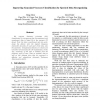Free Online Productivity Tools
i2Speak
i2Symbol
i2OCR
iTex2Img
iWeb2Print
iWeb2Shot
i2Type
iPdf2Split
iPdf2Merge
i2Bopomofo
i2Arabic
i2Style
i2Image
i2PDF
iLatex2Rtf
Sci2ools
ICPR
2008
IEEE
2008
IEEE
Improving Gaussian processes classification by spectral data reorganizing
We improve Gaussian processes (GP) classification by reorganizing the (non-stationary and anisotropic) data to better fit to the isotropic GP kernel. First, the data is partitioned into two parts: along the feature with the highest frequency bandwidth. Secondly, for each part of the data, only the spectrally homogeneous features are chosen and used (the rest discarded) for GP classification. In this way, anisotropy of the data is lessened from the frequency point of view. Tests on synthetic data as well as real datasets show that our approach is effective and outperforms Automatic Relevance Determination (ARD).
Computer Vision | GP Classification | ICPR 2008 | Isotropic Gp Kernel | Outperforms Automatic Relevance |
| Added | 30 May 2010 |
| Updated | 30 May 2010 |
| Type | Conference |
| Year | 2008 |
| Where | ICPR |
| Authors | Hang Zhou, David Suter |
Comments (0)

